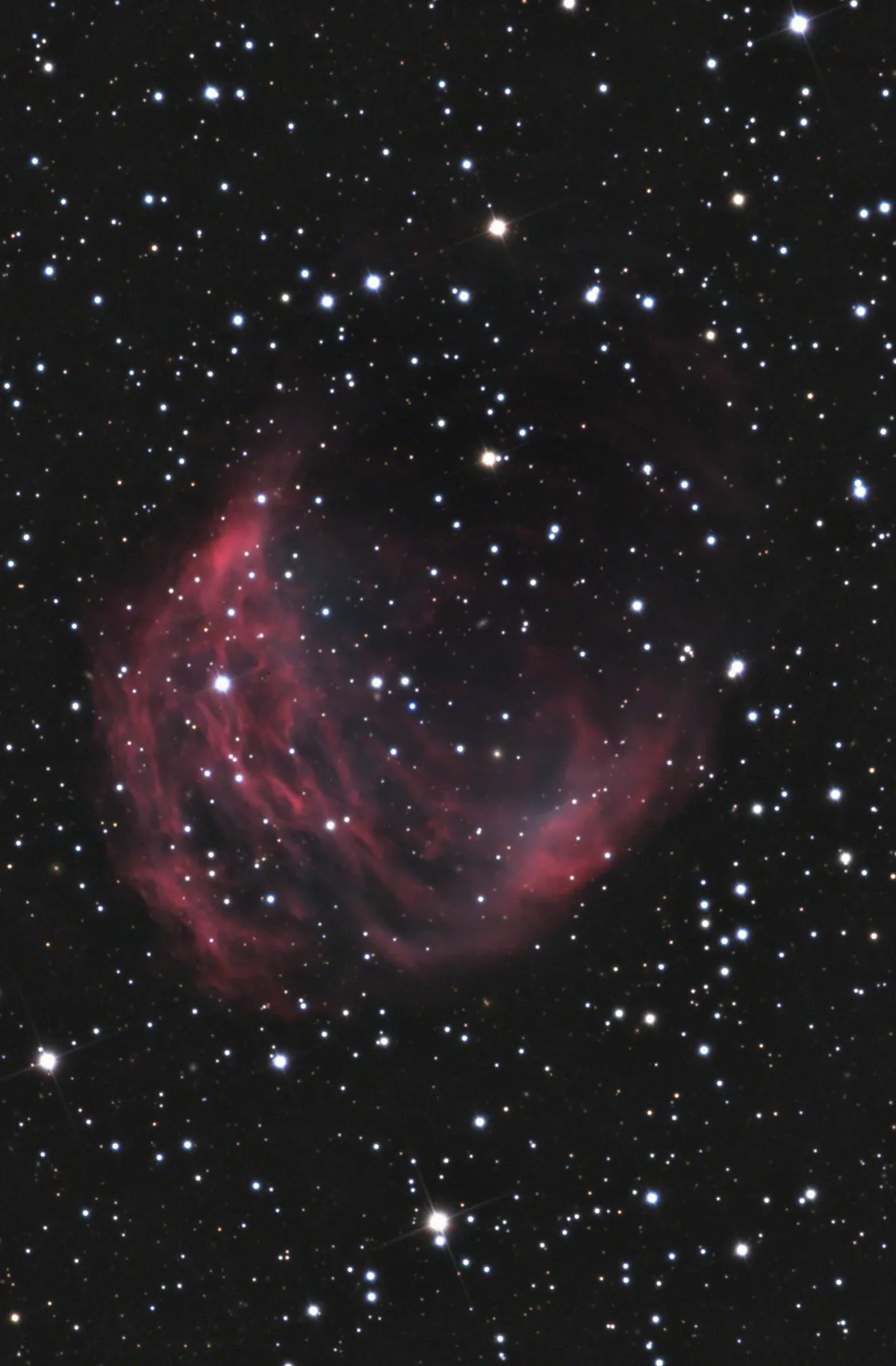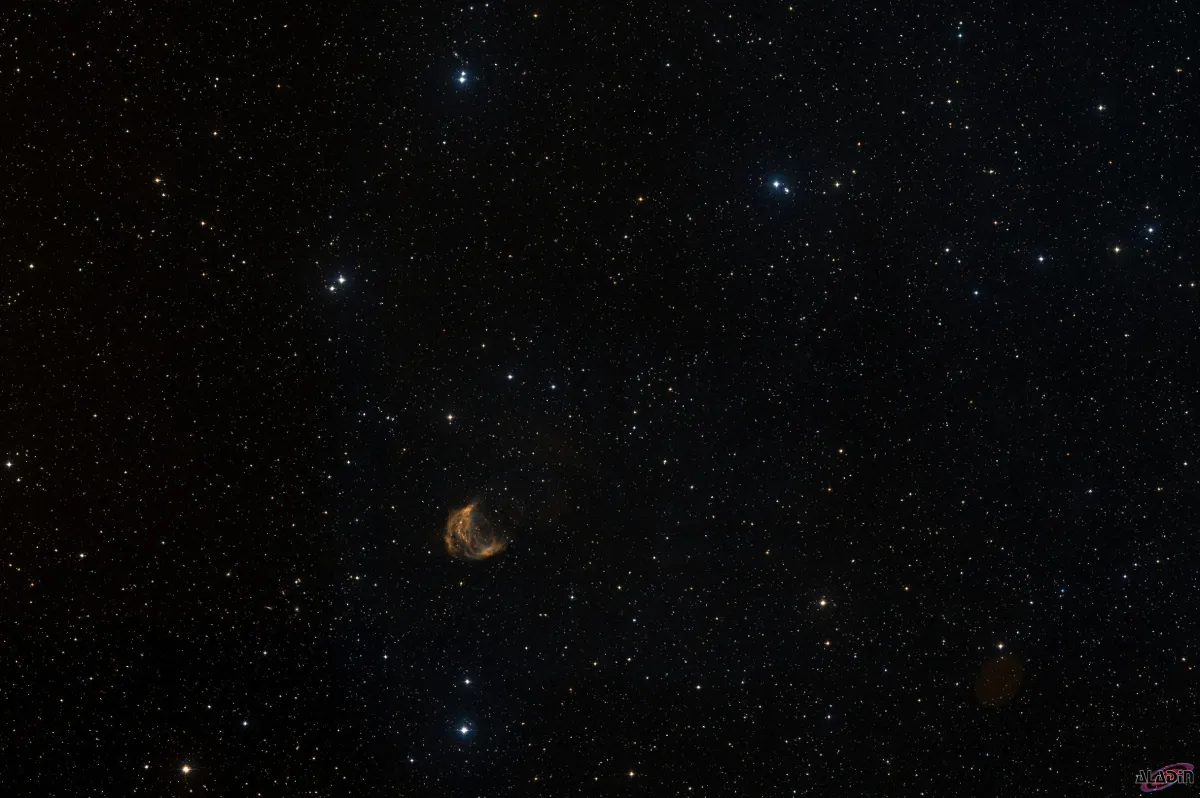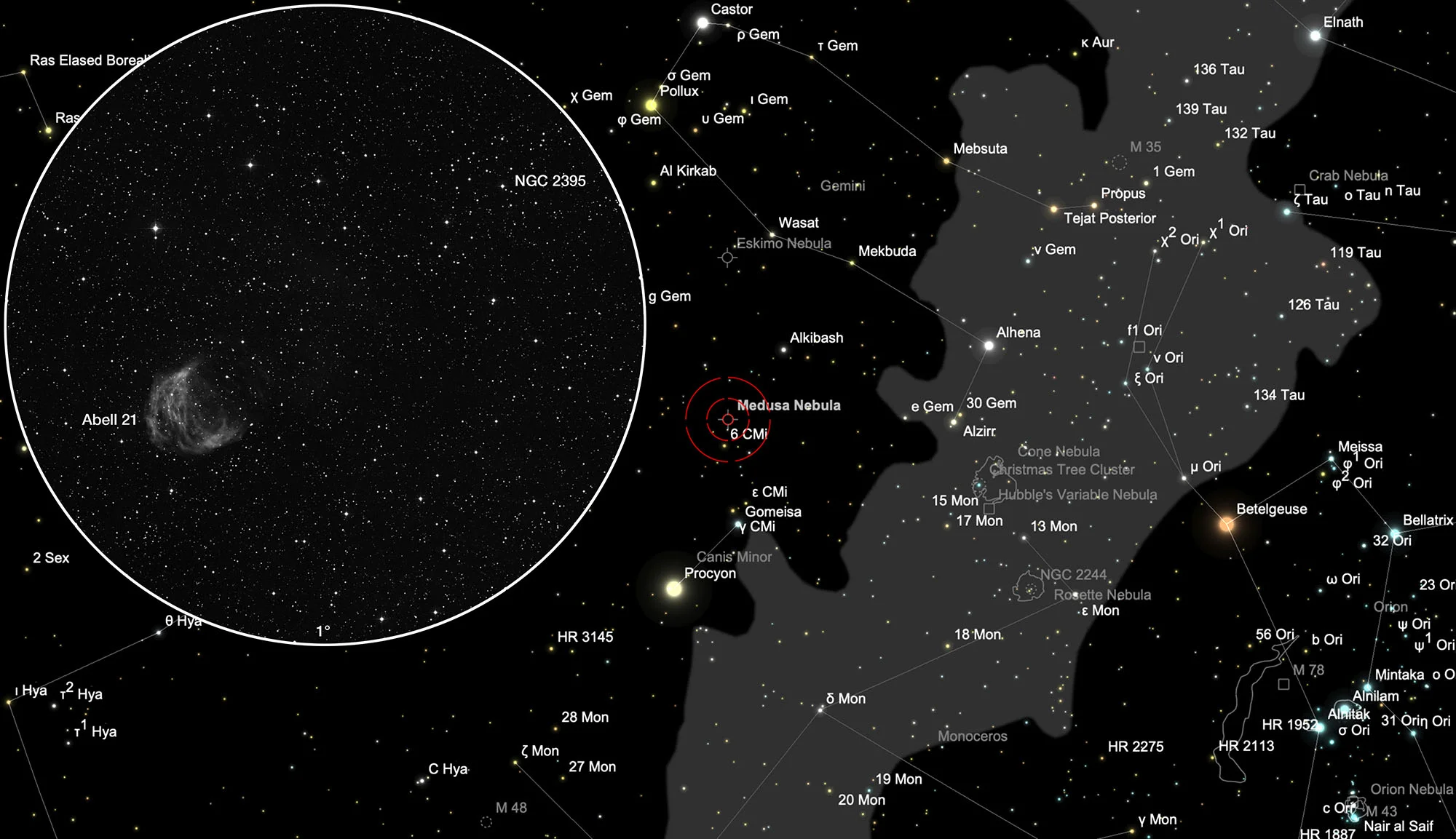Medusa Nebula (Abell 21)


Abell 21
The Medusa Nebula was discovered by George O. Abell on the «Palomar Observatory Sky Survey» (POSS) photo plates at the beginning of the 1950s and listed as the 21st item in his catalog. A few months later, H. M. Johnson tracked him down independently of Abell during his «Survey of Symmetric Galactic Nebulae». Since the appearance of this nebula resembles a jellyfish with winding, fine filaments, it was named «Medusa».
At first, the nebula was understandably identified as a supernova remnant (SNR) because of its size and low luminosity. Its appearance, especially the filament-like structure of the apparent half-shell, looks very similar to an SNR, which is why it was not included in Perek & Kohoutek's «Catalog of Galactic Planetary Nebulae» at first. However, a measurement of the expansion speed of the nebula showed a value that was too low for an SNR, but which corresponded more to that of a PN. In addition, no postsupernova, a neutron star, was found. The chemical composition, which was obtained on the basis of a spectral analysis of the emitted light, and the physical conditions in the nebula also indicated a PN. [94]
The Medusa Nebula is a large planetary nebula about a third of the full moon diameter. The visual brightness is 10.3 and the surface brightness is 15.3 magnitudes. The central star is very weak with almost 16 mag.
| Designations | PN G205.1+14.2: A 21, PK 205+14.1, A55 16, A 21, ARO 388, Sh 2-274, YM 29 |
| Right Ascension (J2000.0) | 07h 29m 03s |
| Declination (J2000.0) | +13° 14' 30" |
| Dimensions | 615." (optical) |
| Expansion Velocity | 64. (O-III) 90. (N-II) km/s |
| C-Star Designations | AG82 82, CSI +13 -07262, UBV 7228 |
| C-Star Magnitude | U: 14.41, B: 15.67, V: 15.99 |
| Discoverer | JOHNSON et al 1971 |

NGC 2395
This loose open star cluster was discovered by William Herschel on 16th March 1784 using his 18.7 inch telescope and cataloged as VIII 11. He just noted: «A cluster of scattered stars.» Dreyer added the cluster in 1888 as NGC 2395. [313, 463]
NGC 2395 is a small, relatively poor open star cluster and, with only 30 stars counted. It is only noticeable because of its slightly higher star density compared to its surroundings. The diameter of this compression is about 12 arc minutes and the brightest stars reach 9.96 magnitudes. The distance is estimated to 512 pc with an age of 1.17490 × 109 years. [138]
| Designation | NGC 2395 |
| Type | OCL (III1p) |
| Right Ascension (J2000.0) | 07h 27m 12.8s |
| Declination (J2000.0) | +13° 36' 30" |
| Diameter | 15 arcmin |
| Visual magnitude | 8.0 mag |
| Metric Distance | 0.071 kpc |
| Dreyer Description | Cl, pRi, C |
| Identification, Remarks | WH VIII 11; GC 1534; OCL 502 |
Finder Chart
The Medusa Nebula is located between the constellations Canis Minor and Gemini. On 12 January it is in opposition to the Sun and crosses the meridian at local midnight. It can best be observed in the months of September to June. There are two simple ways to find the Medusa Nebula. For both, an O-III filter and an eyepiece with at least one degree of field of view are advantageous.
The first method is with the Telrad finder, which is used to align the telescope using the illustration below. The Medusa Nebula is about half a degree southeast of the small open star cluster NGC 2395.
The second method only works with equatorially positioned telescopes. The star Gomeisa (β CMa) is adjusted so that it comes to lie on the western edge of the field of view. Then you lock the hour axis and move the telescope about five degrees to the north in declination. Either you come across the Medusa Nebula first or the open star cluster NGC 2395. The Medusa Nebula has exactly the same right ascension as the star Gomeisa about four minutes further to the east.
Visual Observation
300 mm Aperture: With an O-III filter, this large planetary nebula is easy to find at low magnification. The nebula is easily visible in direct view. If you look slightly past it, the crescent shape becomes more prominent. — 300 mm f/4 Popp Newton, 1996, Bernd Nies
400 mm Aperture: Without an O-III filter, there is no trace of Abell 21 in our light-polluted sky. With an O-III filter, a large, semi-circular nebula becomes visible in the 21 mm Ethos eyepiece, and its shape becomes even clearer with indirect viewing. In the 13 mm Ethos, it appears so large that one cannot look past it to see more. — 400 mm f/4.5 Taurus Dobsonian, Hasliberg, 16. 12. 2023, SQM 21.2, Bernd Nies
762 mm Aperture: The Medusa Nebula Abell 21 appears in high contrast as a thick C or crescent moon shape with a lot of structure. Its high-contrast appearance is surprising for such a relatively faint object. — 30" f/3.3 SlipStream Dobsonian, Hasliberg, 16. 12. 2023, SQM 21.38, Eduard von Bergen
